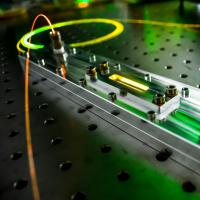Context and Motivation
Current research topics deal with the information and communications technology (ICT), including fiber-based telecommunication systems and fiber sensing technologies, laser physics, nanophotonics, optical metrology, quantum and classical imaging. More specifically, our research group focus on several fields of nonlinear and quantum optics, with the aim of developing potential applications to future ultrafast optical communication systems, supercontinuum laser sources, fiber sensors and quantum imaging.
Objectives and Research Areas
We investigate nonlinear light-matter interactions in many optical materials and waveguides, including photonic crystal fibers, optical nanofibers, chalcogenide glasses, lithium niobate and other nonlinear crystals. Our topics are organized into four main research projects :
› Opto-acoustic interactions in microstructured optical fibers and photonic nanowires: In this project, we investigate the fundamental interactions between light and hypersound waves in both microstructured optical fibers and in photonic nanowires, with the aim of designing and developing new compact devices for all-optical signal processing and sensing technologies. We have demonstrated new interactions such as the generation of surface acoustic waves in optical microfibers, and shear waves in the core of photonic crystal fibers.
› Supercontinuum generation in specialty optical fibers: In this project, we investigate broadband light supercontinuum (SC) generation from the ultraviolet to mid-infrared regions by exploiting nonlinear effects in silica and soft-glass optical fibers. The applications spans from spectroscopy to biomedical optics. We have several academic and industrial collaborators in this project including NKT Photonics, Leukos, SelenOptics, Univ. of Rennes and Cambridge University.
› Information and quantum imaging: The aim of this project is to investigate quantum properties of light in the spatial domain using nonlinear optics in quadratic crystals. We focus in particular on spatial quantum correlations and entanglements in spontaneous parametric down-conversion. Correlations of twin images in both the near and the far fields have recently been demonstrated with a high degree of Einstein-Podolsky-Rosen paradox (EPR).
› Lithium niobate-based photo-induced waveguides: this project aims at developing functional photonic chips based on lithium niobate (LiNbO3) by means of soliton-induced waveguiding. LiNbO3 ridge waveguides are also manufactured by precision dicing for effiicient second-harmonic generation.
Members
- Thibaut Sylvestre, CNRS Researcher Director
- Jean-Charles Beugnot, CNRS Researcher
- Mathieu Chauvet, Professor, UFC
- Fabrice Devaux, Professor, UFC
- Eric Lantz, Professor, UFC
- Gil Fanjoux, Professor, UFC
- Kien Phan Huy, Associate Professor, UFC
- Hervé Maillotte, CNRS Research Director
- Jérôme Salvi, Associate Professor, UFC
- Alexis Mosset, CNRS Research Engineer
Post-doctoral researchers and Ph. D Students
- Jacques Chretien
- Adrien Godet
- Moise Deroh
- Vincent Pecheur
- Solveig Perret
- Amar Nath Ghosh
- Olivia Zurita Miranda
- Gnatiessoro Soro
Former post-doctoral researchers and Ph. D Students
- Abdoulaye Ndao
- Tintu kuriakos
- Séverine Denis
- Joël Cabrel Tchahame Nougnihi
- Birgit Stiller
- Arnaud Mussot
- Min Won Lee
- and many others collegaues and friends !
Expertise
Our research group conducts both fundamental and applied research with practical applications, including some projects directly linked to current and future needs of photonics industry. Our group is nationally and internationally recognized for its pioneering works on supercontinuum generation and parametric amplification in optical fibers, photon-phonon interactions in photonic crystal fibers, photorefractive solitons, nonlinear quantum imaging and optical parametric amplification of images.

